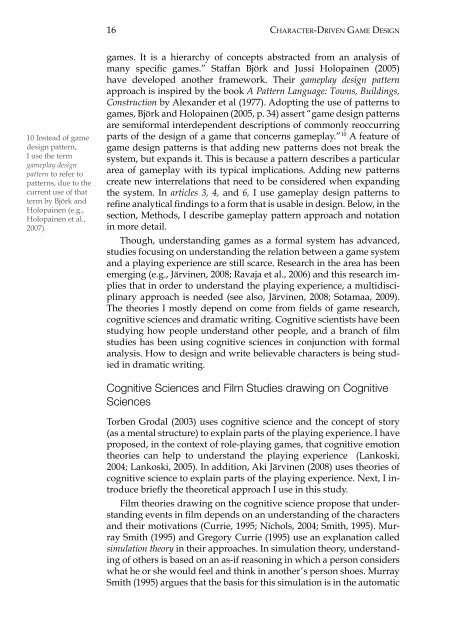Character Driven Game Design
Character Driven Game Design
Character Driven Game Design
Create successful ePaper yourself
Turn your PDF publications into a flip-book with our unique Google optimized e-Paper software.
16<br />
<strong>Character</strong>-<strong>Driven</strong> <strong>Game</strong> <strong>Design</strong><br />
10 Instead of game<br />
design pattern,<br />
I use the term<br />
gameplay design<br />
pattern to refer to<br />
patterns, due to the<br />
current use of that<br />
term by Björk and<br />
Holopainen (e.g.,<br />
Holopainen et al.,<br />
2007).<br />
games. It is a hierarchy of concepts abstracted from an analysis of<br />
many specific games.” Staffan Björk and Jussi Holopainen (2005)<br />
have developed another framework. Their gameplay design pattern<br />
approach is inspired by the book A Pattern Language: Towns, Buildings,<br />
Construction by Alexander et al (1977). Adopting the use of patterns to<br />
games, Björk and Holopainen (2005, p. 34) assert “game design patterns<br />
are semiformal interdependent descriptions of commonly reoccurring<br />
parts of the design of a game that concerns gameplay.” 10 A feature of<br />
game design patterns is that adding new patterns does not break the<br />
system, but expands it. This is because a pattern describes a particular<br />
area of gameplay with its typical implications. Adding new patterns<br />
create new interrelations that need to be considered when expanding<br />
the system. In articles 3, 4, and 6, I use gameplay design patterns to<br />
refine analytical findings to a form that is usable in design. Below, in the<br />
section, Methods, I describe gameplay pattern approach and notation<br />
in more detail.<br />
Though, understanding games as a formal system has advanced,<br />
studies focusing on understanding the relation between a game system<br />
and a playing experience are still scarce. Research in the area has been<br />
emerging (e.g., Järvinen, 2008; Ravaja et al., 2006) and this research implies<br />
that in order to understand the playing experience, a multidisciplinary<br />
approach is needed (see also, Järvinen, 2008; Sotamaa, 2009).<br />
The theories I mostly depend on come from fields of game research,<br />
cognitive sciences and dramatic writing. Cognitive scientists have been<br />
studying how people understand other people, and a branch of film<br />
studies has been using cognitive sciences in conjunction with formal<br />
analysis. How to design and write believable characters is being studied<br />
in dramatic writing.<br />
Cognitive Sciences and Film Studies drawing on Cognitive<br />
Sciences<br />
Torben Grodal (2003) uses cognitive science and the concept of story<br />
(as a mental structure) to explain parts of the playing experience. I have<br />
proposed, in the context of role-playing games, that cognitive emotion<br />
theories can help to understand the playing experience (Lankoski,<br />
2004; Lankoski, 2005). In addition, Aki Järvinen (2008) uses theories of<br />
cognitive science to explain parts of the playing experience. Next, I introduce<br />
briefly the theoretical approach I use in this study.<br />
Film theories drawing on the cognitive science propose that understanding<br />
events in film depends on an understanding of the characters<br />
and their motivations (Currie, 1995; Nichols, 2004; Smith, 1995). Murray<br />
Smith (1995) and Gregory Currie (1995) use an explanation called<br />
simulation theory in their approaches. In simulation theory, understanding<br />
of others is based on an as-if reasoning in which a person considers<br />
what he or she would feel and think in another’s person shoes. Murray<br />
Smith (1995) argues that the basis for this simulation is in the automatic
















